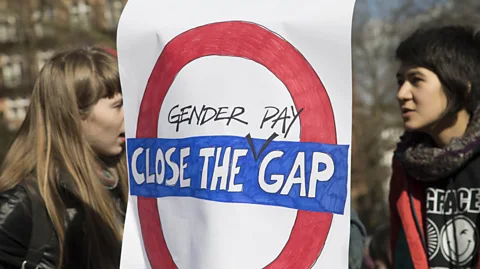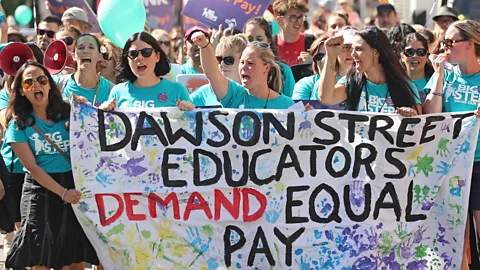The loopholes that disguise the gender pay gap
 Getty
GettyAll UK companies with 250 employees or more have to publish an annual gender pay report. But some factors can mask the scale of salary imbalance, writes Josie Cox.
London-based journalist Kate had been contemplating leaving her job at a national newspaper for some time. In February she finally quit after receiving an offer from a much larger company that would almost double her salary.
The pay rise was a major incentive but her former employers' reluctance to publish its gender pay gap had also been bothering her.
The gender pay gap is the difference in average wages earned by men and women. It’s driven by multiple factors, including women switching to part-time work to accommodate caring responsibilities, men climbing faster by taking fewer career breaks as well as – in some cases – outright discrimination.
You might also like:
Since 2017, all UK companies with 250 employees or more have been obliged to publish an annual gender pay gap report, setting out the mean and median salary for each gender, as well as information on bonuses and the breakdown of each gender in different pay brackets.
Reporting guidelines are prescribed across all businesses, leaving no doubt which employees must be counted, but some companies appear to have identified ways of skirting the legislation.
Kate, who is originally from Ireland and asked not to use her real name to protect her identity, says that although her former firm is small it uses dozens of freelancers and casual workers. If employed on contract, she believes they could the tip headcount over 250.
"Personally, I felt like by not reporting, the company was dodging the law and it just doesn't sit right with me," she reflects. "The media has been so vocal on the subject, so by not putting their money where their mouth is, they're really compromising their own integrity."
The BBC has pledged to close its gender pay gap by 2020, but reported that in 2018 it paid its mean female employee 8.4% less than its mean male employee, down from 10.7% the previous year. The median gender pay gap was 7.6%, down from 9.3%.
 Getty
GettyA global problem
The new UK requirements follow measures implemented by other countries to crack down on inequality. Scandinavian nations have been trailblazers; in Norway tax returns (and hence salary information) have been publicly available for years, while last year Iceland became the world’s first country to establish processes to legally enforce equal pay. In Australia, the opposition party says it would introduce UK-style reporting legislation.
But globally the picture remains bleak: According to the World Economic Forum’s global gender gap report published in December 2018, the world’s gender pay gap last year was 51%. At the current pace of progress, it would take 202 years before women can earn the same as men and have equal job opportunities, the organisation said.
When the latest UK pay gap data came out earlier this month, it showed no significant improvement year-on-year – the median pay gap went from 9.7% to 9.6%. Yet there may be more fundamental problems to address to get a clear picture of the problem: UK firms are being trusted to self-audit and there are numerous loopholes they can exploit to disguise the extent of a salary imbalance.
Dr Heejung Chung, from the University of Kent’s School of Social Policy, says that one of the big problems is around outsourcing. Large institutions, like universities, tend to have outsourcing contracts for services like catering and cleaning. “Often those workers are low paid and often they’re female,” Dr Chung says. If they were included as employees, it would considerably skew the gender pay gap in favour of men.
Helene Reardon Bond, former director of gender equality for the UK government, says that she's heard of consultancies advising employers to set up new legal entities "so that companies can hive off parts of their business", meaning that lower paid divisions are ed for elsewhere.
There are also no measures in place to stop firms splitting into multiple smaller entities of fewer than 250 employees, exempting them from having to publish any gender pay gap data at all.
 Getty
GettyInadequate checks
Several large professional services and law firms last year came under fire for arguing that their top-earning partners, who in most cases were predominantly male, were “owners” rather than “employees”, thereby taking them out of pay gap calculations.
The firms later yielded to government pressure to restate their figures to include their partners’ salaries, but some still have highly paid advisers who don’t appear on the employee payroll because the companies argue they're external contractors or consultants.
At a more basic level, even after the figures have been logged, the mechanisms for checking the accuracy are very limited.
An investigation by the Financial Times in 2018 showed that one in 20 gender pay gap reports were statistically improbable and therefore likely to be inaccurate. For instance, 16 companies originally claimed to pay their average male and average female employees identical salaries, yielding a gender pay gap of zero. Several – including Hugo Boss and the North Tyneside branch of Age UK – later restated their figures.
And hundreds of companies this year have reported figures that look statistically unlikely, with the gender pay gaps by quartile not aligning with the median calculation or pay gaps of over 100%.
The Equality and Human Rights Commission is the regulator for the legislation, but Bond says that the commission's powers are "quite clunky for this sort of process and publication requirements".
Charles Cotton, senior pay and reward adviser at the UK’s Chartered Institute of Personnel and Development, which provides evidence to the government on legal issues like pay, redundancy and pensions, says that he has yet to see evidence of companies actively manipulating their figures, but that he’s nonetheless concerned about accuracy.
It’s easy for errors to creep into reporting, he says, particularly “if the data is split across payroll, people and finance systems that don’t talk to each other”.
But some critics suggest firms may be paying lip-service to the law. Last year, when the British government announced it would not extend reporting requirements to smaller firms, MP Rachel Reeves said she would continue “to put pressure on companies to comply with the spirit as well as the letter of the law to ensure that the reported data is meaningful”.
 Alamy
AlamyWhat are the solutions?
It’s much easier to implement sanctions when it’s obvious that a business is not making progress on diversity – senior management may be all male, for example. And that’s where change – albeit at a glacial pace – appears to be happening.
Scores of large investors, particularly asset managers in like Axa, Amundi and BNP Paribas Asset Management, have in recent years focused on socially responsible funds that steer clear of investments in companies that sell alcohol and tobacco, promote gambling or warfare, or contribute to environmental damage.
And diversity could be the next frontier when it comes to the ethical parameters for big money investing.
In February, UK-based Hermes Investment Management, a prominent investor which manages in excess of £33bn ($43bn), said it would be taking a tougher stance on gender diversity by voting against FTSE 100 chairs who fail to address executive committees or boards lacking in gender diversity. Others could follow suit.
Cotton from the CIPD points to and as countries setting positive examples when it comes to improving transparency and thereby effecting change.
“In , every employee can request a pay comparison against six comparable employees of the opposite sex,” he explains. “Individuals can then go to court if they believe they’ve been discriminated against. To date, there have been relatively few employee requests, but this is likely to change as more people become aware of its availability.”
Like the UK, it’s illegal in to pay men and women different salaries for the same work. But discrepancies facilitated by a pay secrecy culture still exist and are a contributory factor in the gender pay gap.
In , meanwhile, employers with a headcount of 1,000 and above are awarded a score out of 100 based on criteria which includes their pay gap and promotion rates. Employers that score below 75 are given three years to improve their ratings. If they don’t, they face a fine equivalent to 1% of their payroll.
has also announced that it will roll out special software to monitor corporate payrolls for gender pay gaps.
Bond, the former UK government adviser, says it is the Scandinavian countries which “stand out with universal child care, excellent parental and maternity leave packages". These matter, she says, because the gender pay gap often becomes more pronounced when women take time out to start a family. Policies in Sweden incentivise fathers to take breaks to care for children too.
Back in the UK, Cotton wants a concrete action plan for improvement so that companies can be held more able.
“It is a concern that around one third of organisations are continuing to publish their pay gap figures in isolation,” he says. “You would never release a set of financial results without an explanation; the same should be true for their gender pay gap figures.”
To help reduce their gender pay gaps, employers should review the whole of the “employment life cycle”, Cotton believes.
“That means examining policies and practices concerning recruitment and retention, management, training and development, reward and recognition, as well as the design of the organisation, work and jobs,” he adds. “Little improvements in each of these areas could make a big difference overall.”
To comment on this story or anything else you have seen on BBC Capital, please head over to our Facebook page or message us on Twitter.
If you liked this story, sign up for the weekly bbc.com features newsletter called "If You Only Read 6 Things This Week". A handpicked selection of stories from BBC Future, Culture, Capital and Travel, delivered to your inbox every Friday.
{"image":{"pid":""}}
